HOME
INTRO
SYMBOLS
ALMANAC
ECONOMY
GEOGRAPHY
STATE MAPS
PEOPLE
GOVERNMENT
FORUM
NEWS
COOL SCHOOLS
STATE QUIZ
BOOK STORE
MARKETPLACE
STATE LINKS
GUESTBOOK
CONTACT US
| Report broken link | |
| All the presidents |


John Adams (1735 - 1826)
In Article II, Section 1 of the Constitution of the United States of America, the following requirements are stipulated for those wishing to hold the office of the President of the United States.
No person except a natural born Citizen, or a Citizen of the United States, at the time of the Adoption of this Constitution, shall be eligible to the Office of President; neither shall any Person be eligible to that Office who shall not have attained to the Age of thirty-five Years, and been fourteen Years a Resident within the United States.
2nd President of the United States (1797-1801)
Learned and thoughtful, John Adams was more remarkable as a political philosopher than as a politician. "People and nations are forged in the fires of adversity," he said, doubtless thinking of his own as well as the American experience.
| John Adams: | |
|---|---|
| Source: University of Virginia, Miller Center of Public Affairs, www.millercenter.virginia.edu, May 17, 2007. | |
| 2nd President of the United States | |
| Born: | October 30, 1735, North Precinct of Braintree (now Quincy), Massachusetts. |
| Nickname: | "Atlas of Independence" |
| Education: | Harvard College (graduated 1755). |
| Religion: | Congregationalist, Unitarian |
| Marriage: | October 25, 1764, to Abigail Smith (1744-1818) |
| Children: | Abigail Amelia (1765-1813), John Quincy (1767-1848), Susanna (1768-1770), Charles (1770-1832), Thomas Boylston (1772-1832) |
| Career: | Lawyer |
| Political Party: | Federalist |
| President: | One term (four years) from 1797-1801. |
| Age at inauguration: | 61 |
| Died: | July 4, 1826, in Quincy, Massachusetts. |
| Interred: | United First Parish Church: Quincy, Massachusetts. |
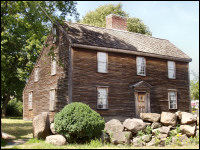 |
| John Adams' Birthplace
Quincy, Massachusetts Adams National Historic Park |
Adams was born in the Massachusetts Bay Colony in 1735. A Harvard-educated lawyer, he early became identified with the patriot cause; a delegate to the First and Second Continental Congresses, he led in the movement for independence.
During the Revolutionary War he served in France and Holland in diplomatic roles, and helped negotiate the treaty of peace. From 1785 to 1788 he was minister to the Court of St. James's, returning to be elected Vice President under George Washington.
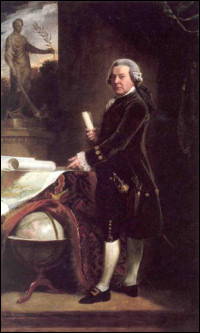 |
| John Adams by John Singleton Copley
Harvard University Collection |
Adams' two terms as Vice President were frustrating experiences for a man of his vigor, intellect, and vanity. He complained to his wife Abigail, "My country has in its wisdom contrived for me the most insignificant office that ever the invention of man contrived or his imagination conceived."
When Adams became President, the war between the French and British was causing great difficulties for the United States on the high seas and intense partisanship among contending factions within the Nation.
His administration focused on France, where the Directory, the ruling group, had refused to receive the American envoy and had suspended commercial relations.
Adams sent three commissioners to France, but in the spring of 1798 word arrived that the French Foreign Minister Talleyrand and the Directory had refused to negotiate with them unless they would first pay a substantial bribe. Adams reported the insult to Congress, and the Senate printed the correspondence, in which the Frenchmen were referred to only as "X, Y, and Z."
The Nation broke out into what Jefferson called "the X. Y. Z. fever," increased in intensity by Adams's exhortations. The populace cheered itself hoarse wherever the President appeared. Never had the Federalists been so popular.
Congress appropriated money to complete three new frigates and to build additional ships, and authorized the raising of a provisional army. It also passed the Alien and Sedition Acts, intended to frighten foreign agents out of the country and to stifle the attacks of Republican editors.
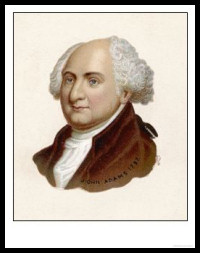 |
| John Adams (1735 - 1826)
Posters and Prints |
President Adams did not call for a declaration of war, but hostilities began at sea. At first, American shipping was almost defenseless against French privateers, but by 1800 armed merchantmen and U.S. warships were clearing the sea-lanes.
Despite several brilliant naval victories, war fever subsided. Word came to Adams that France also had no stomach for war and would receive an envoy with respect. Long negotiations ended the quasi war.
Sending a peace mission to France brought the full fury of the Hamiltonians against Adams. In the campaign of 1800 the Republicans were united and effective, the Federalists badly divided. Nevertheless, Adams polled only a few less electoral votes than Jefferson, who became President.
On November 1, 1800, just before the election, Adams arrived in the new Capital City to take up his residence in the White House. On his second evening in its damp, unfinished rooms, he wrote his wife, "Before I end my letter, I pray Heaven to bestow the best of Blessings on this House and all that shall hereafter inhabit it. May none but honest and wise Men ever rule under this roof."
Adams retired to his farm in Quincy. Here he penned his elaborate letters to Thomas Jefferson. Here on July 4, 1826, he whispered his last words: "Thomas Jefferson survives." But Jefferson had died at Monticello a few hours earlier.
Source: www.WhiteHouse.gov, May 17, 2007.
Presidential $1.00 coin:
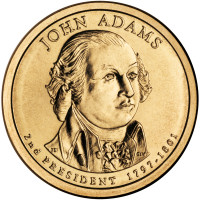 |
| U.S. Mint Image |
Born in the Massachusetts Bay Colony in 1735, John Adams was one of the earliest and most vocal advocates for colonial independence. The Harvard-educated lawyer served as a delegate to both the First and Second Continental Congresses.
A skilled diplomat, Adams lived in France and Holland during the Revolution, working to secure crucial international support and recognition of American independence. He served eight years as George Washington's Vice-President before winning the Presidency in 1797.
Elected by a margin of just three electoral votes (71-68), John Adams was the first President to live in the White House, arriving in Washington on November 1, 1800. On his second evening in its damp, unfinished rooms, he wrote to his wife, "Before I end my letter, I pray Heaven to bestow the best of Blessings on this House and all that shall hereafter inhabit it. May none but honest and wise Men ever rule under this roof."
Coinage Legislation under President John Adams
Act of February 1, 1798: This Act suspends, for a period of three years, a portion of the Act of February 9, 1793, relating to the acceptance of foreign coinage as legal tender in the United States.
Act of April 24, 1800: This Act authorizes the purchase of copper equivalent to the number of cents and half-cents produced during the prior year, and authorizes an annual purchase to continue the striking of these coins.
Act of March 3, 1801: This Act directs the location of the United States Mint to remain in Philadelphia until March 1803.
United States Mint Directors appointed by President Adams
- None.
Source: www.USMint.gov, May 17, 2007.
Additional resources:
John Adams America's Story from America's Library, the Library of Congress.
American Presidents: Life Portraits A Site to Complement C-SPAN's 20th Anniversary Television Series, American Presidents: Life Portraits.
John Adams (1735 - 1826) American President: An Online Reference Resource from the Miller Center of Public Affairs, University of Massachusetts. In-depth information reviewed by prominent scholars on each President and administration.
John & Abigail Adams
Companion site to PBS American Experience program. Purchase
John & Abigail Adams
from Amazon.com.
John Adams John Adams from Wikipedia, the free encyclopedia.
Presidential Inaugurations: John Adams Presidential Inaugurations is presented by the Library of Congress, and other governmental departments, in collaboration with the Avalon Project at the Yale Law School. This presentation includes diaries and letters of presidents and of those who witnessed inaugurations, handwritten drafts of inaugural addresses, broadsides, inaugural tickets and programs, prints, photographs, and sheet music.
ADAMS, John, (1735 - 1826) Biographical Directory of the United States Congress.
John Adams Papers "The Papers of John Adams" from The Avalon Project at Yale Law School.
A Tradition of Celebration by the Adams Family Researched by James R. Heintze, Assistant University Librarian, The American University. All Rights Reserved.
John Adams (1735-1826) Biography of John Adams from the Massachusetts Historical Society.
Adams National Historic Park Adams National Historical Park tells the story of four generations of the Adams family (from 1720 to 1927). The park has two main sites: the Birthplaces of 2nd U.S. President John Adams and 6th U.S. President John Quincy Adams, and Peacefield including the "Old House," home to four generations of the Adams family, and the Stone Library which contains more than 14,000 historic volumes.
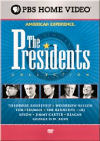
The Presidents
Collection DVD
John Adams,
by David McCullough, 736 pages, Simon & Schuster (May 22, 2001).
The Letters of John and Abigail Adams,
by by Abigail Adams, John Adams, Editor: Frank Shuffelton, 512 pages, Penguin Classics (December 30, 2003).
John Adams: The American Presidents Series,
by John Patrick Diggins, 224 pages, Times Books; 1st ed edition (June 11, 2003).
John Adams and the Spirit of Liberty,
by C. Bradley Thompson, 340 pages, University Press of Kansas (November 1998).
The Revolutionary John Adams,
by Cheryl Harness, Reading level: Ages 9-12, 48 pages, National Geographic Children's Books (January 1, 2003).
Site designed exclusively for NETSTATE.COM by NSTATE, LLC

NETSTATE.COM is a Trademark of NSTATE, LLC.
Copyright © by NSTATE, LLC. All rights reserved.
No copyright is claimed on non-original or licensed material.
Support NETSTATE


